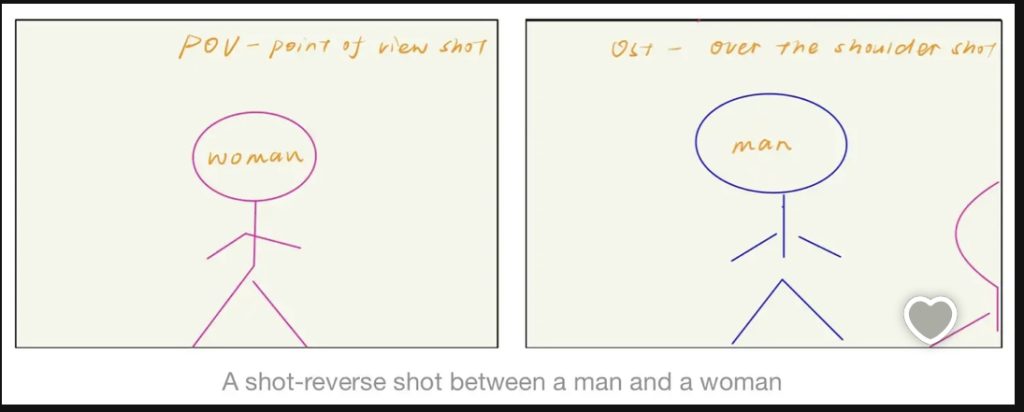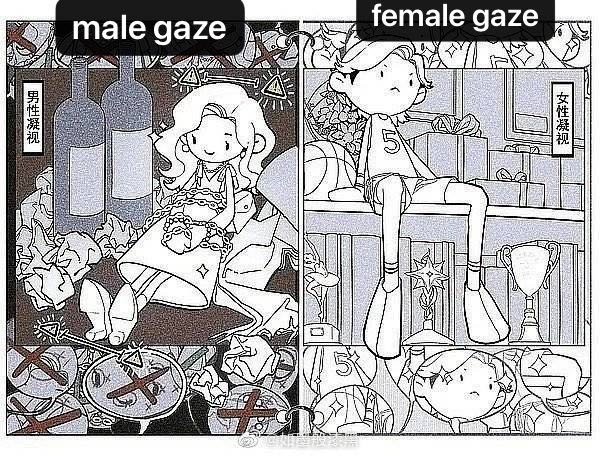Imagine this scenario: you’re shopping in a clothing shop and a short pink dress looks good and compliments the lines of your body nicely, but you think it’s too short and you might suffer comments from your colleagues. In the end, you opt for a beige dress; it’s simple, generous and elegant in tone, and it makes you look feminine without being overly bold. The way you look in the mirror seems to represent many kinds of judgemental voices from the outside world. You look beautiful now because someone is probably watching, judging — you feel the presence of the male gaze.
The male gaze is everywhere – a concept that is a key word in contemporary theories of gender studies, film studies, cultural studies, etc., and describes the ways in which women and non-males are perceived as sexual objects through the hegemonic lens of masculinity.
The gaze differs from ordinary “looking” in that it has more complex cultural meanings and visual metaphors. In the academic literature on the gaze, you’ll almost always find a paper called “Visual Pleasure and Narrative Cinema,” where the “gaze,” as a term in film criticism, was first born. To sum up the central idea of this essay in one sentence – men look, women are looked at. Under the male gaze, women become dominated and subordinate to male desire, an “empty reference”. Let’s pick out a few interesting points from the paper and discuss them together.
First of all, you can look back at the behind-the-scenes documentaries, or stills, that you have seen in the past. Are most of the directors, cinematographers, editors, and other people who have a say in the camera’s work old men? Mulvey also notes this point, and argues that because a higher percentage of men in the film industry take on these important roles, scenes, characters, and other visual elements are deliberately or unintentionally affected by this division of labour. An example cited by Ms. Dai Jinhua in her previous comments is a good way to help understand this point: Thinking back to those forward and backward shots of men and women’s dialogue in classic Hollywood films, over-the-shoulder shots that appear to show a girl’s shoulders are often used when showing a man speaking, whereas subjective shots that do not appear to show a boy’s shoulders are often used when showing a woman speaking. Simply put, the camera leads the viewer, unconsciously, into the boys’ perspective. This may seem like a coincidence, but it is certainly an interesting phenomenon when this coincidence happens in almost every film. However, considering that the paper was published in 1973, we can all take note of it when we watch films in generalŌĆ” is this the case in films from the last few years as well? Are there any differences in camera presentation between films made by male and female directors? Is this also the case in video games, short videos?

Another interesting point is that Mulvey believes that male viewers identify with the image of the male protagonist they see leading the plot. Viewers see a fascinating, powerful, perfect character on screen and (unconsciously) want to be like him – they identify with the man. At the same time, by identifying with their ‘selves’, female viewers also gaze at the female body through the eyes of the male character instead. Women want to be desired in a similar way and to present themselves as sexual objects. The darkened cinema actually encourages viewers not to interact with each other in order to lose themselves in the story and accept the camera’s perspective. These processes occur largely unconsciously for the viewer. Cinema (and we might say audiovisual media more generally) responds to our biological drive to see. (This mechanism requires us to reflect on something deeper behind women’s “needs”. For example, under what circumstances is the “love of make-up to please oneself” not valid?)

Through this male gaze, Hollywood cinema reproduces and maintains a patriarchal society where women are passive and men are active. Women, in turn, learn and become better at “playing” this gender in the face of this pervasive male gaze. As gender theorist Judith Butler emphasises in her paper Performative Acts and Gender Constitution, gender is essentially a performance. Sex (understood as biological sex) is separate from gender (understood as social gender), which is a set of idealised templates passed down from generation to generation, and is an action that constructs the identity it implies, rather than a mere reproduction exercised by the subject that precedes it.

![What is this [male condensation] that we are rebelling against?](https://blog6.theories-of-media.com/wp-content/uploads/sites/7/2023/12/6bff74903dbd08900ed4d5192bb3b36.jpg)
You’re doing good! In your blog, I could understand what you wanted to explore through your writing. Should it be the concept and example of the male gaze? In your first big paragraph you illustrate the way men scrutinise women in film and media and how this scrutiny affects the viewer. And you also mention theoretical perspectives, and references to the 1973 paper. This is what made me feel that you did a really great job.
You draw interestingly on the text “Visual Pleasure and Narrative Cinema” and apply your own take on it, discussing the type of shots that are used when looking at a man versus a woman. I found your text to be great, but I would have loved it even more if there had been a “real world” example for us to see applying the theories you talk about and explain in depth. I found your blog very interesting and easy to read. You cleverly paint a picture which grabs the reader’s attention and puts us in the shoes of the woman you are initially describing.
Your blog was very interesting to read and I was hooked on every sentence. You wrote your blog out in the best way to keep it engaging but giving us examples and by also explaining how Mulvey looks at the male gaze. I really enjoyed your example in the first paragraph of the blog it gave me a visual into what the male gaze is like. I also totally agree with your point when you say the males
are active and the females are passive. It’s a great comparison.